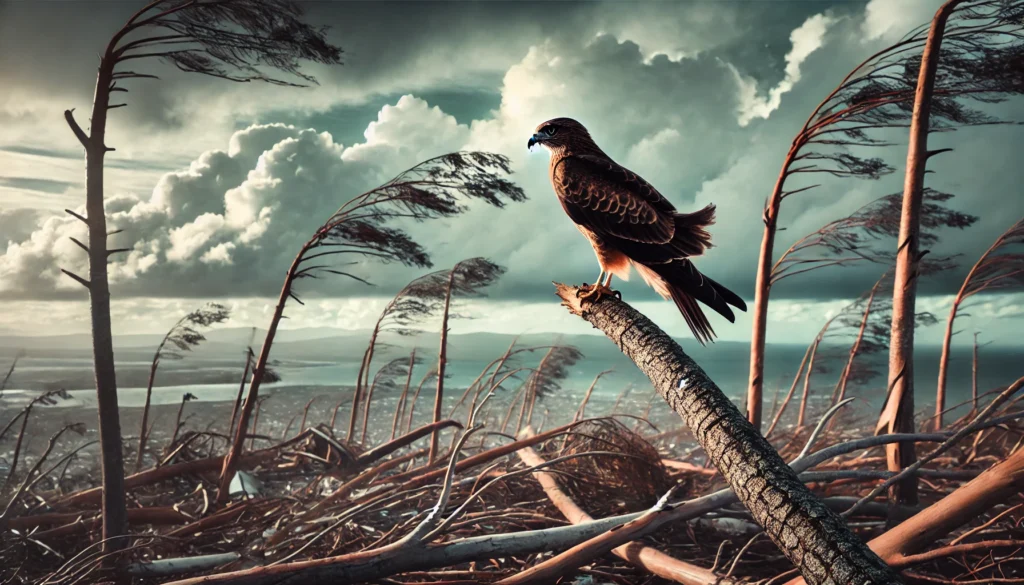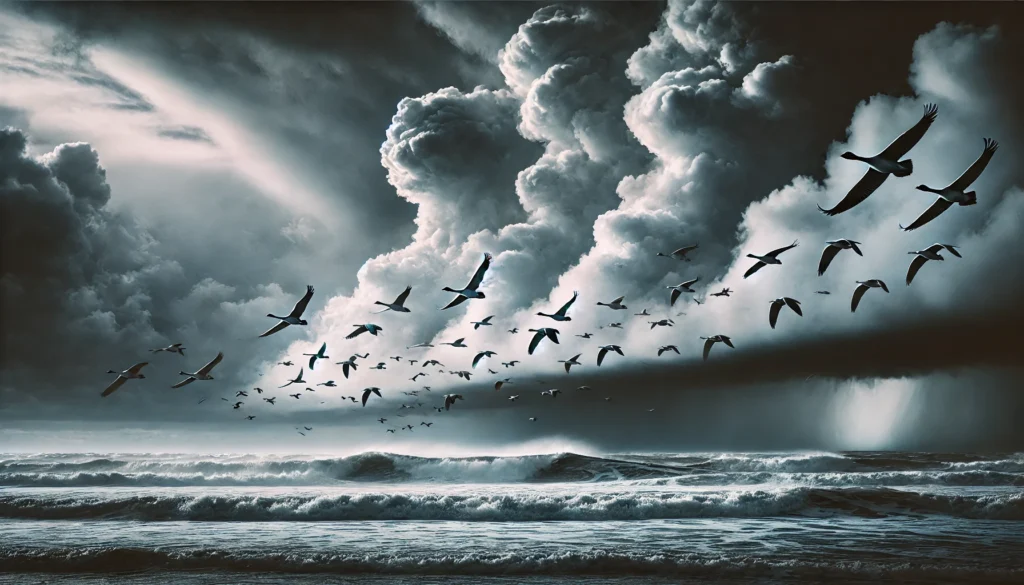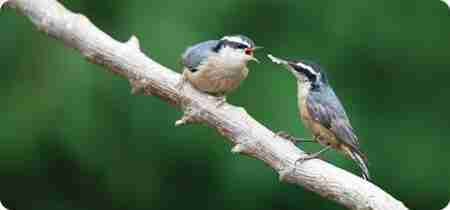Have you ever wondered what happens to birds when a massive storm rolls in during migration season? Well, when Hurricane Helene barreled through, she left behind more than just uprooted trees and swirling winds—she also changed the course of many feathered travelers. In this article, we’ll take a deep dive into how Hurricane Helene impacted bird migration, the specific challenges birds faced, and what it all means for our winged friends and the birdwatching community. We’ll explore both the science behind these disruptions and the inspiring resilience these incredible creatures display.
How Hurricanes Influence Bird Migration
If you want to dive deeper into how hurricanes like Helene impact bird behavior, check out our guide on how birds respond during a hurricane. It gives a more detailed look at bird responses during these intense weather events.
Picture this: a flock of warblers is halfway through its long journey, coasting along the Atlantic Flyway, when a gigantic storm like Hurricane Helene forms ahead of them. Birds are incredibly resourceful, but hurricanes throw in a chaotic mix of wind currents, heavy rains, and altered landscapes. The typical response? Birds may get blown off course, forced to find new places to rest, or even driven to exhaustion as they struggle against the storm’s powerful winds.
When hurricanes form during peak migration seasons, they become a significant obstacle for birds, leading to severe consequences. Hurricanes can force birds to expend more energy than they planned, impacting their physical health and even their ability to survive. Wind direction plays a crucial role in this—birds attempting to avoid hurricane-force winds can be pushed miles off their regular route, often ending up in completely unsuitable habitats.
Storm-Induced Fallout: Birds Far from Home
Some species might even end up in completely unexpected places, a phenomenon birders call a “fallout.” Imagine an exhausted warbler landing in a suburban backyard, far from its typical woodland destination, or a seabird finding refuge on a small inland pond. Suddenly, a quiet coastal town could find itself hosting rare species that are way off their usual migration routes. It’s kind of like a surprise birding jackpot—though one that comes with a high cost for the birds themselves.
“Fallout” is not only a term for birds blown off course; it’s a dramatic event where entire flocks of migrating birds are forced down from the skies by severe weather. These fallouts can concentrate large numbers of birds in one location, providing birdwatchers with a unique, though heartbreaking, opportunity to observe species they wouldn’t normally see. For the birds, though, it’s a matter of survival: their priority is finding food and safety after an exhausting, disorienting experience.
The Impact of Hurricane Helene on Bird Migration
For more insights on how changing climate factors affect migratory birds, you might enjoy our article on the unexpected changes in bird migratory patterns. It helps explain broader trends that influence migrations beyond hurricanes.
Hurricane Helene was no exception when it swept through. Many birds caught in Helene’s winds were blown far off course, leading to some surprising sightings along the coast. Shorebirds like sandpipers and plovers, normally sticking to more southerly destinations, found themselves seeking shelter in unexpected spots much further north. This migration disruption means exhausted birds, desperate for food and rest, in locations where they might struggle to find what they need.

The aftermath of Hurricane Helene saw significant disruptions across several bird species:
- Shorebirds and Waders: Shorebirds like plovers and sandpipers were spotted in unusual inland locations as they sought refuge. Normally, these birds thrive in coastal estuaries, where mudflats provide abundant food. After the hurricane, many were found far from their ideal feeding grounds, struggling to adapt to unfamiliar habitats.
- Passerines (Songbirds): Many small migratory songbirds, such as warblers, were significantly impacted. These birds depend on specific stopover sites rich in food resources to refuel. Hurricane-force winds pushed them far from these critical stopovers, causing unexpected fallouts in urban areas, fields, and even parking lots.
- Seabirds: Perhaps the most striking effects were seen among pelagic seabirds. Petrels, shearwaters, and other species typically found far out to sea were suddenly appearing along inland lakes and even in urban water bodies. These seabirds, accustomed to the open ocean, were disoriented and desperately needed to regain their bearings.
- Raptors: Birds of prey, like hawks and falcons, which usually migrate by riding thermal currents, were also thrown off their migratory paths. Disrupted by the turbulent winds, many of these raptors ended up migrating later than usual or in unexpected directions, which could potentially affect their hunting success and survival rates.
Physiological Impacts on Birds Post-Hurricane
The physical toll hurricanes take on birds can be immense. Migrating already requires significant energy, and when birds are forced to battle hurricane-strength winds, it pushes their endurance to the limits. Hurricanes like Helene can leave birds in a state of exhaustion—sometimes with fatal consequences. After spending days trying to find safety, their energy reserves are depleted, increasing their susceptibility to predation, disease, or starvation.
Research has shown that hurricanes can also interfere with the timing of migration. Birds depend on predictable environmental cues—like temperature and wind direction—to determine when to migrate. A powerful storm can delay this process, forcing birds to arrive late at their breeding or wintering grounds, which impacts their ability to find food and secure nesting sites.
Birdwatching After the Storm: What to Look For
After major weather events like hurricanes, birdwatching can take on a new light. Interested in observing some fascinating flight behaviors? Have a look at the unique behavior of starlings during flight. These mesmerizing patterns can tell us a lot about bird survival strategies.
For birdwatchers, post-hurricane fallout can present unique opportunities. After Hurricane Helene, birders reported unusual sightings—including pelagic seabirds, normally seen only far offshore, suddenly appearing near coastal towns and even inland lakes. These storms can create what’s known as a “wreck” where seabirds are temporarily stranded far from their ocean homes, offering a rare and bittersweet chance to observe them up close.
If you’re an avid birder, keep an eye out after hurricanes. Look for birds that don’t normally show up in your area. Check beaches, large bodies of water, and even urban green spaces where tired birds may take refuge. Just be mindful that these birds have been through a lot, and they’re in desperate need of rest and food. A gentle approach will help them recover.
Post-hurricane birding is also an opportunity to contribute to science. By documenting your sightings on platforms like eBird, you’re providing valuable data that helps researchers understand the broader impacts of climate events on bird populations. Patterns of displacement, unusual arrivals, and the timing of these occurrences are all pieces of a larger puzzle that scientists are keen to solve.

Hurricane Season and Long-Term Effects on Bird Populations
The resilience of birds during these tough times is inspiring. If you’d like to see examples of how some birds come back from near extinction, read about the unbelievable resurgence of the Kirtland’s warbler and California condor. It’s a testament to how nature, with a little help, can bounce back.
Hurricanes are becoming more frequent and intense due to climate change, which means increased disruption for bird migrations in the future. Hurricane Helene is just one example of a broader trend that is posing challenges for birds around the globe. Repeated disruptions can lead to longer-term population declines, especially for species that are already vulnerable.
Species like the Black Skimmer or the Piping Plover, which depend on coastal habitats for nesting, are particularly at risk. Hurricanes can completely reshape shorelines, eroding dunes and sandbars that serve as nesting grounds. Repeated exposure to these storms without sufficient recovery time can make it difficult for populations to rebound.
Resilience and Adaptation: How Birds Cope with Hurricanes
Despite these challenges, birds are incredibly resilient. Adaptation is part of the natural world, and many species have learned to cope with, and even take advantage of, the tumultuous environment. Migrating birds are equipped with finely tuned instincts that allow them to sense changes in barometric pressure, helping them make decisions to avoid the worst of a storm. While these natural cues aren’t always foolproof, they do help mitigate some risks.
Moreover, birds are opportunistic by nature. After a hurricane, when landscapes are altered, certain bird species may find new feeding opportunities. For example, woodpeckers and other insectivores may thrive on fallen trees, where insects quickly gather. Similarly, raptors may benefit from the changed environment, as displaced or weakened prey become easier targets.
How We Can Help Our Feathered Friends
One of the best ways we can make a difference is by understanding how birds adapt. For an inspiring story of resilience, check out our article on the resilience of endangered Willow Flycatchers in San Diego. It offers a glimpse into how conservation efforts help these birds thrive despite challenges.
So, what can we do to help birds affected by hurricanes like Helene? Here are a few ideas:
- Provide Food and Water: Migrating birds are often exhausted after battling hurricane winds. Setting up feeders with high-energy seeds, suet, or nectar can be a lifesaver for many species needing a pit stop. During migration periods, a well-stocked bird feeder can mean the difference between life and death for many individuals.
- Protect Habitat: Birds need safe places to rest, and hurricanes often destroy or damage their usual stopovers. By supporting conservation efforts that protect critical habitats—especially wetlands and coastal areas—you can help give them the safe havens they need. Consider supporting local initiatives that focus on habitat restoration, particularly those that work to stabilize shorelines or replant native vegetation.
- Support Bird-Friendly Building Practices: Urban areas can be dangerous for migrating birds, especially after being blown off course. Reflective windows, lights at night, and a lack of green spaces all pose significant risks. Advocating for bird-friendly architecture—like the use of window decals and reduced nighttime lighting—can help keep birds safer in cities.
- Report Sightings: Post-hurricane sightings are valuable data points for researchers. By reporting unusual sightings on birding apps or citizen science platforms like eBird, you contribute to our collective understanding of how storms impact bird migration. This data helps scientists track movement patterns and can lead to better-informed conservation decisions.
- Participate in Citizen Science Projects: There are several citizen science projects aimed at understanding bird migration and how environmental factors like hurricanes affect them. By joining projects like Project FeederWatch or Global Big Day, you not only learn more about birds, but you also contribute valuable data.
- Create Backyard Sanctuaries: If you have a backyard, transform it into a sanctuary for birds. Plant native plants that offer shelter and food, avoid pesticide use, and ensure there’s water available. Your backyard can be an oasis for weary travelers.

Migration Resilience: A Lesson in Adaptability
Hurricane Helene is a reminder of just how resilient birds are—and also how much they need our support. Migration is already one of the most grueling journeys in the natural world, and when you throw hurricanes into the mix, it becomes even more challenging. By providing food, protecting habitats, and sharing our observations, we can help these incredible travelers recover and continue their journey.
Bird migration is a natural wonder, but it’s also fraught with perils that many of us can’t even begin to imagine. When hurricanes strike, birds are thrust into a life-and-death struggle. Despite the immense challenges, they continue, driven by instinct and an incredible will to survive. Our role, as bird enthusiasts and conservationists, is to support them in any way we can.
Next time you spot a tired warbler or a displaced petrel, remember that you’re witnessing a story of survival against some pretty extreme odds. And maybe, just maybe, you can help write a better ending for them.
What Have You Seen?
Have you spotted any unusual birds after Hurricane Helene, or any other storm for that matter? We’d love to hear your stories and sightings! Share your experience in the comments below, or drop by our community page to connect with other bird enthusiasts. Together, we can make a difference—one bird at a time.



